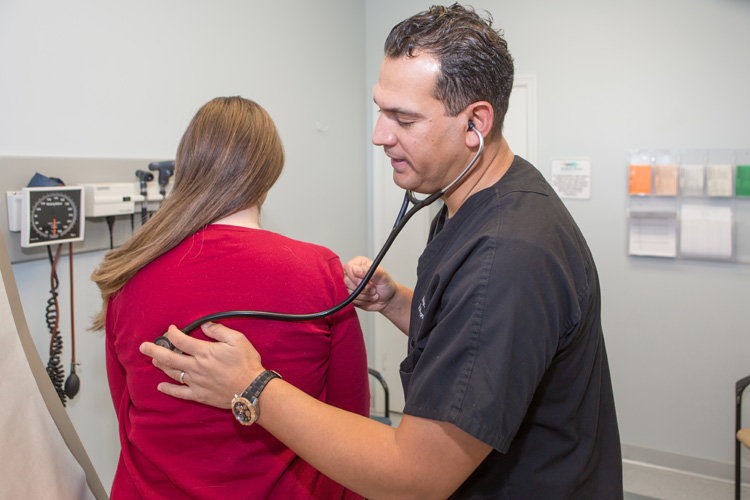Mattress companies can’t seem to resist telling you how much of your life is spent sleeping – about one-third of the average person’s lifespan – but people with obstructive sleep apnea reap only a fraction of the health benefits a good night’s sleep can provide.
In fact, their health is actually threatened when they sleep.
Just ask Dr. Hermes Velasquez at Cleveland Clinic Indian River Hospital.
Board-certified in sleep medicine as well as pulmonary medicine and critical care, Velasquez can recite a staggering list of risks faced by those who have this condition and are not currently getting treatment.
That list, composed by the National Heart, Lung and Blood Institute, includes “asthma, atrial fibrillation, certain cancers including pancreatic, renal and skin cancers, high blood pressure, chronic kidney disease, cognitive and behavioral disorders such as decreases in attention, vigilance, concentration and motor skills, as well as dementia in older adults.”
In short, obstructive sleep apnea – which causes people to stop breathing while they sleep – is a good deal more serious than most people think. Those with the conditions may stop breathing hundreds of times a night – sometimes for 10 or 15 seconds, sometimes for several minutes at a time. As a result, the brain and the rest of the body don’t get enough oxygen.
Sleep apnea’s cause is relatively simple. The muscles in the back of the throat fail to keep your airway open. The tongue, tonsils and soft palate collapse, blocking the airway. Close to 30 percent of the U.S. population has this problem, but most of them don’t know it.
Sleep apnea appears to be most common in older adults, but children and younger adults can have it, too. And the vast majority of cases – roughly 80 percent, according to the American Sleep Apnea Association – are currently undiagnosed.
According to Harvard University Health, “the most effective current therapy for sleep apnea is provided by continuous positive airway pressure – or CPAP – machines.”
These devices have been around in the United States since the 1980s, but Velasquez says there have been many improvements over the years. He says the newest “interfaces” or masks, or nasal buds, “have improved significantly.”
More good news for patients in Vero, Velasquez says the newly renovated and redesigned sleep center at Cleveland Clinic Indian River Hospital makes proper diagnosis of sleep disorders much more appealing and comfortable for patients.
The test conducted at the sleep center, known as a “polysomnogram,” monitors brainwave activity, heart rhythm, breathing, blood oxygen levels and movements while a patient sleeps. Other patients are able to use small, iPhone-size take-home monitors without checking into the sleep center overnight.
Asked if snoring is an infallible symptom of sleep apnea, the affable and engaging Velasquez quickly replies with a, “No, no, no! Almost everybody that has sleep apnea will snore, but not all snorers have sleep apnea. There’s a condition called primary snoring [in which] you just snore but you don’t create any problems. You don’t drop your oxygen. You don’t stop breathing. You don’t wake yourself up. You only wake up your bed partner, maybe, but you’re fine.”
That said, Velasquez does admit “maybe 30 to 35 percent of my patients come to see me because of snoring and they are being dragged here by their bed partners.” But for those with A-Fib, that spouse-induced visit can be a life-saving – or at the very least – a life-enhancing move.
“After [age] 65 in males,” Velasquez explains, “about 20 to 25 percent have some sort of sleep apnea. That’s one in every five. That’s a lot.”
Another FDA-approved treatment for obstructive sleep apnea is the “advanced mandibular device,” a metal-hinged contraption worn by the patient that forces the lower jaw (mandible) forward, altering the position of the tongue during sleep.
Velasquez cautions that mandibular devices “have to be done right by a certified dentist and custom made to your teeth.” It is not something to purchase from a TV ad or online. The effect of the device also needs to be monitored.
“You need to be tested after the appliance is done with another sleep test to make sure your events are completely resolved,” Velasquez says.
Another, more high-tech form of therapy is a “Hypoglossal pacemaker.” These implanted devices sense breathing activity and use an electric signal to stimulate the diaphragm and restart breathing, but Velasquez says “not everyone qualifies for those.”
Signs and symptoms of obstructive sleep apnea can include “excessive daytime sleepiness, loud snoring, observed episodes of breathing cessation during sleep, abrupt awakenings accompanied by gasping or choking, awakening with a dry mouth or sore throat, morning headaches and difficulty concentrating during the day,” according to the Mayo Clinic.
If you are experiencing any of those symptoms, it makes sense to consult your primary care physician or a sleep medicine professional.
If you are currently using a CPAP machine, Medicare and most insurance policies will allow you to replace your current device every five years at little or no cost.
Dr. Hermes Velasquez is board certified in sleep medicine, pulmonary medicine and critical care and is with Cleveland Clinic Indian River Hospital. His office is at 3450 11th Circle, Suite 203 in Vero Beach. The phone number is 772-794-5800.

